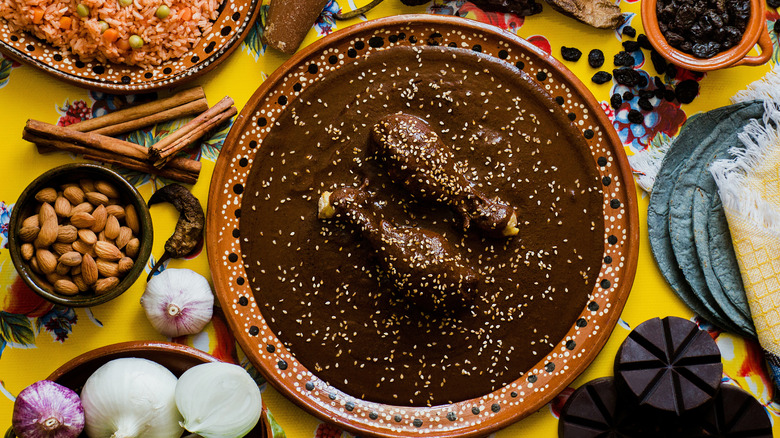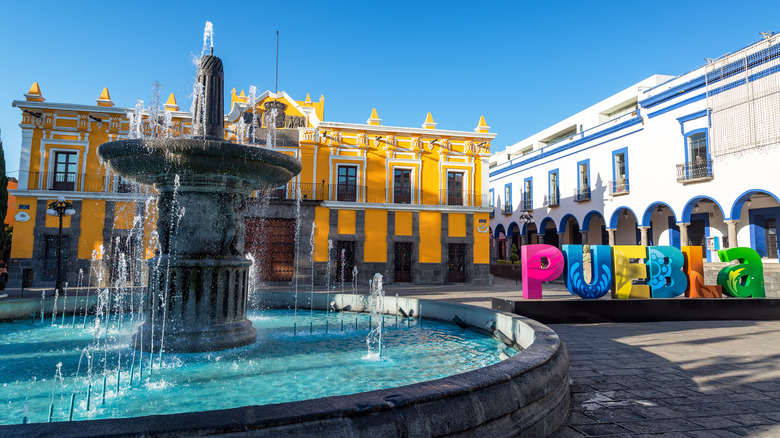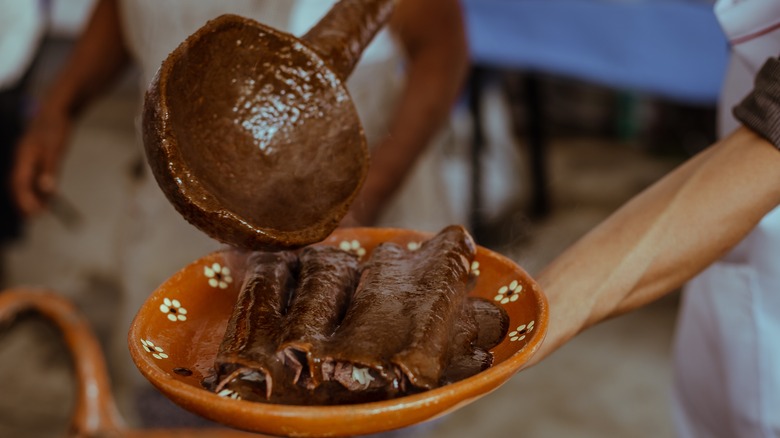How Mole Poblano Became The Signature Dish For Cinco De Mayo
The Cinco de Mayo holiday commemorates Mexico's victory over French forces, and the subsequent win at the Battle of Puebla on May 5, 1862. In America, many view this date as an opportunity to indulge in large quantities of tacos and margaritas in a celebratory manner, but in Mexico, it's common to savor a dish intimately connected to the site of the famous triumph.
While the holiday is celebrated throughout Mexico, it is especially prominent in Puebla, which is about 84 miles southeast of Mexico City. It is a city that has long been recognized for its culinary treasures; in fact, several respected names in the restaurant and food industry consider Puebla to be the gastronomic capital of Mexico. Among the most famous of dishes that has come out of Puebla is mole poblano, a dark, rich, savory sauce often served with meats like chicken or turkey.
On an episode of the History Channel's "Holiday Foods," restaurateur Zarela Martinez described the dish as the "jewel of Puebla food," and one of the characteristic dishes of Mexican cuisine, often used to celebrate weddings and baptisms. Essentially, both the Cinco de Mayo holiday and mole poblano are products of Puebla, so it only makes sense that the stew is one of the most popular foods to enjoy on the fifth of May in its country of origin.
Mole poblano has always been a celebratory specialty
By the time of the Battle of Puebla, mole poblano was already established as a renowned dish from the city. The story goes that modern mole poblano was first created in the late 1600s by Sor Andrea de la Asunción, a nun at Puebla's Santa Rosa convent. She developed the dish in anticipation of an impending visit from the new viceroy of Puebla from Spain. Since its inception, mole poblano has been prepared and enjoyed during times of celebration — in fact, because making it from scratch is so labor-intensive, it is typically reserved for special occasions. Mole sauce (pronounced "moh-lay") often requires more than 20 ingredients, and can take several hours, if not a full day, to complete. It is a true labor of love that involves toasting, soaking, frying, straining, sauteing, and simmering the ingredients.
The numerous ingredients — including chocolate, corn, chilies, fruit, nuts, and seeds — result in a sauce that is earthy, nutty, thick, and spicy all at once. The sauce is commonly ladled over meat, but it can also be used as an enchilada sauce (which likewise enhances fried eggs), sopped up with tortillas, drizzled on tacos, or poured onto tostadas with a sprinkle of queso fresco on top.
Other Puebla-born dishes to enjoy on Cinco de Mayo
Mole poblano is arguably the most recognized and enjoyed mole sauce outside of Mexico. You can even find it pre-made in jars in many supermarkets. Besides this Puebla-born treasure, there are mole negro from Oaxaca, mole verde, mole amarillo, and mole manchamantel. However, to celebrate Cinco de Mayo authentically, opt for mole poblano, even if you just toss it with some chicken and place it inside a taco.
Chiles en nogada is also a specialty of the city of Puebla, and is popularly consumed during the celebration in Mexico. Regarding beverages on the fifth of May, forgo the margaritas and paloma cocktails; historically, tequila (or its earlier version, called pulque) could only be consumed by priests, because it was considered a drink for the gods. Instead, consider a lesser-known beverage called chumiate, which is enjoyed on special occasions in Puebla. It's a fermented infusion of several teas and capulin cherries. In the city, you can also find tepache, a fermented pineapple drink flavored with honey and anise.



